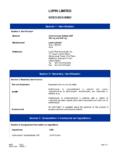Transcription of Blowing Agent Masterbatches - luvobatch.de
1 Blowing Agent Masterbatches for lighter plasticsThe products named in this brochure reflect only a fraction of our portfolio. We specialize in products that meet your agents are primarily used for purposes of density reduction, which enables weight reduction in the final product and lower costs. Additional and improved product qualities can be a further advantage in using chemical Blowing agents. improved heat and noise insulation better dielectric properties improved impact-absorbing properties prevention of sink marks in the injection mold decorative Blowing agents get more out of your plasticsChemical Blowing agents are reactive additives that release gases during the processing of thermoplastics.
2 Thus, they enable the production of foamed plastic for various applications. Gases develop by means of a thermally activated decomposition reaction that occurs during the processing of the masterbatch, generating a stable and defined plastic foam. With chemical Blowing agents, a general distinction is made between endothermal and exothermal systems, each of which have different characteristics. Our experts will conduct a thorough consultation to determine which solution is the right one for your application. Powder: low dosing, handling disadvantages Masterbatch (normal and microgranulate): dust-free, precise dosing, good dispersionTypical substances in chemical Blowing agents include: Endothermal:Carbonates, mixtures with carbonatesExothermal:ADCA, OBSH, TSHOur LUVOBATCH products come in different forms:Examples include: LUVOBATCH Examples of useRecommended dosageRecommended processing temperatureGas yield [ml/g]Decomposition temperature [ C]Approx.
3 Blowing Agent content [%]FormUC BA 1006 Granulate2017030> marksTSGE xtrusionPE BA 9060 Granulate70145110> marksTSGE xtrusionPE BA 9537 Micro-granulate2014020> Plate, pipe, profile, and film extrusion, Blow molds and cable sheathingNucleating Agent for physical foamingPE BA 9539 Granulate6615070> Plate, pipe, profile, and film extrusion,Blow molds and cable sheathingTSG, internal gas pressure, weight reductionEV BA 9546 Granulate2014020> % % %ExtrusionInjection moldingNucleationEndothermal Blowing agents Gas yield approx.
4 100 130 ml/g Higher dosing quantities compared to exothermal Blowing agents May require greater chromium content in the tool (with high citrate component) Possible blooming effects Controlled foaming process Very fine cell structure Shorter cycle times Reduced streaking Prevention of post-expansion Approved for food packaging Endothermal LUVOBATCH Blowing agents for controlled reactionWhen exposed to heat and shear these Blowing agents decompose and release non-toxic gases. In many cases these gases are carbon dioxide and water vapor the most common active agents are carbonates and carboxylic acids.
5 Since externally supplied heat is consumed during the reaction, these products are called endothermal Blowing agents. The advantage with these products is that gas formation stops any time when the energy supply is interrupted and can be restarted in a controlled Examples of useRecommended dosageRecommended processing temperatureGas yield [ml/g]Decomposition temperature [ C]Approx. Blowing Agent content [%]Form Gas yield approx. 220 ml/g for azodicarbonamide Low dosing quantities (see comparison to endothermal) Even gas distribution Not corrosive No blooming NOT approved for food packagingEV BA 5391 Micro-granulate45160120> phrExtrusion of hard PVC in pipe, plate and profileEV BA 5322 Micro-granulate50155120> phrExtrusion of hard PVC, especially foam core pipePV BA 9791 Compac-tate70160165> phrExtrusion of hard PVC.
6 Especially foam core pipeEV BA 5056 Granulate3915090> core pipesFree-foam platesCeluka profilesPW BA 9507 Powder80145180> Blowing agentsExothermal LUVOBATCH Blowing agents for high pressureUpon initiation by irridiation, heat or other forms of energy, exothermal Blowing agents release during their composition heat and gases such as nitrogen, carbon dioxide, or ammonia. Here, the active agents are primarily azodicarbonamide and sulfohydrazide. Exothermal Blowing agents are widely used in the industry because of their high effectivity and good foaming results.
7 LUVOBATCH Examples of useChemical Blowing agents as nucleation for physical and chemical foaming The nucleating properties of chemical Blowing agents enables the physical and chemical foaming to achieve a smoother and finer foam structure, thus optimizing the properties of their components. Nucleation provides the optimal combination of both technologies when particularly smooth foams with extra fine cells are and nucleated Blowing agents for fine structures Mixtures of exothermal and endothermal Blowing agentsCombining the advantages of both action principles, we also offer mixtures of endothermal and exothermal Blowing agents.
8 These Masterbatches are optimally customized to your application and your needs. An additional effect is the finer foam structure that arises through the interaction of different Blowing dosageRecommended processing temperatureGas yield [ml/g]Decomposition temperature [ C]Approx. Blowing Agent content [%]FormLUVOBATCH Examples of useRecommended dosageRecommended processing temperatureGas yield [ml/g]Decomposition temperature [ C]Approx. Blowing Agent content [%]FormPE BA 1096 Granulate2015525> 1 % Sink marksTSGE xtrusion NucleationPW NUK 1143 Powder100130150> BA 1065 Granulate3718075> 180< marksTSGE xtrusionEV BA 9341 Granulate / Micro-granulate65145110> marksTSGE xtrusionPE BA 9551 mikroMicro-granulate4014575> phrFoam core pipesFree-foam platesCeluka us:LUVOBATCH Lehmann&Voss&Co.
9 KGHamburg-Wandsbek (plant) Schimmelmannstra e 103 22043 Hamburg Tel: +49 / 40 / 44 19 7 482 Fax: +49 / 40 / 44 19 7 614 E-mail: 2013/10 B&P






